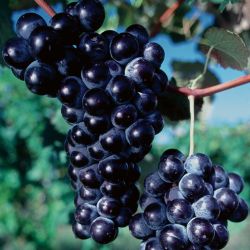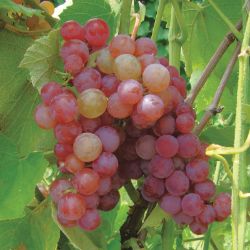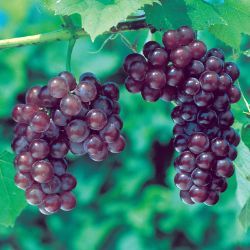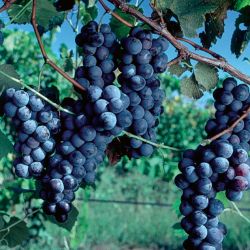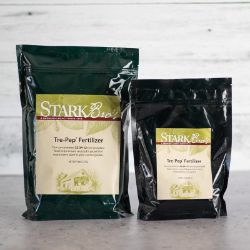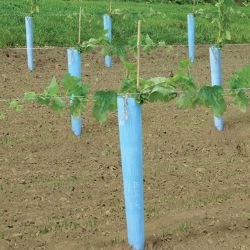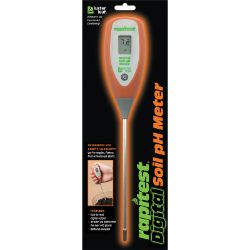Pest & Disease Control for Grape Vines
Every plant has the future potential for disease and insect damage. Factors such as location and weather will play a part in which issues your plants encounters. If available, disease-resistant varieties are the best option for easy care; and for all types of plants, proper maintenance (such as watering, pruning, spraying, weeding, and cleanup) can help keep most insects and diseases at bay.
NOTE: This is part 7 in a series of 11 articles. For a complete background on how to grow grape vines, we recommend starting from the beginning.
Downy Mildew
Yellow spots appear on leaves with downy spots on underside of foliage. Older leaves in center of vine are infected first. Can infect fruits, become soft, grayish, wither, may or may not have downy symptom. Over-winters on fallen leaves, so fall clean up is vital.
Natural Control
- Monterey Liquid Copper Fungicide
Chemical Control
- Monterey Fruit Tree Spray Plus (berries only)
- Hi-Yield® Captan 50W Fungicide
Armillaria Root Rot
White knots between the bark and hardened at or below the soil line. Infected tissues have a mushroom-like odor when moist. Black fungus strands that look somewhat like roots, may be formed on the outside of the roots. During fall and early winter, fungus may produce mushroom-like fruiting bodies at the soil line around the trunk. Plant may die quickly or may show a slow decline with wilting leaves, and/or small dark green leaves. Disease progresses by root contact with infected plants. Soil fumigation may be necessary.
Control
- Consult County Extension Agent
Scale
Usually on bark of young twigs and branches, encrusted with small (1/16”) hard, circular, scaly raised bumps with yellow centers, may also be on fruit. Sap feeding weakens vine.
Natural Control
- Monterey Horticultural Oil
- Safer® Brand Insect Killing Soap
- Monterey Fruit Tree Spray Plus
Chemical Control
- GardenTech® Sevin® Concentrate Bug Killer
Black Rot
Reddish-brown spots on leaves, spots soon appear on fruit, turn black. Then entire fruit becomes black, hard, shriveled mummy. Disease usually infects vine from bottom up. Over winters in fallen mummies (some mummies may cling on plant and can transmit disease also). Fall clean up is critical in control.
Natural Control
- Monterey Liquid Copper Fungicide
Chemical Control
- Monterey Fruit Tree Spray Plus
- Hi-Yield® Vegetable & Ornamental Insect Control
Botrytis Bunch Rot
May cause early season shoot blight following spring rains. Flowers can become infected during bloom. Then becomes dormant until sugar content of the infected berries increases later in the season. Infected berries split then leak and the fungus continue to grow. Intact ripe berries can be infected as harvest nears. Berries damaged by insects or birds are more susceptible. Removal of some leaves around the clusters can help control the disease. Don’t remove too many, especially on side that receives afternoon sun, to prevent sunburn of fruit. Fungus over-winters in berry mummies on ground and hanging on vine. Fall clean up is critical.
Chemical Control
- Monterey Fruit Tree Spray Plus
Eutypa Dieback
Seldom seen in vines less than 8 years old. Most readily recognized symptoms are noticed during first 2 months of annual growth. They are malformed and discolored shoots, young leaves are small, cupped and often develop small necrotic spots and tattered margins. Grape clusters on affected shoots may have mixture of large and small berries. Symptoms become more extensive each year until part or the entire arm fails to produce shoots in the spring. Prune directly after a rain risk of infection is lowest at this time and prune late in dormant season to promote rapid healing. Spray or hand-paint large pruning wounds with fungicide soon after pruning and before rain.
Natural Control
- Remove and destroy all infected wood.
Other Control Options
- Consult County Extension Agent
Anthracnose (Bird’s-Eye Rot)
Black or brown lesions appear, especially on young leaves. Center of lesion becomes grayish-white and dries, may fall out giving a shot-hole appearance. May affect the shoots and the berries. Lesions on berries have dark brown or black margin, center is violet gradually becoming whitish-gray.
Natural Control
- Monterey Liquid Copper Fungicide
Powdery Mildew
Appears as red blotchy areas on dormant canes. First appears on leaves as pale yellow or white spots on the upper surface. Soon a white webby substance appears and the white powdery masses. Fruit may be completely covered. Fungus may over-winter in dormant buds.
Natural Control
- Monterey Fruit Tree Spray Plus
Black Measles
During summer or early autumn leaves on white varieties show yellow and red varieties show reddish patches, which enlarge and dry out. Severely infected leaves may drop and canes die back from the tip. On berries small round dark spots, bordered by a brown purple ring, may occur. Spots may appear any time between fruit set and ripening. In severely infected vines, berries may crack and dry on the vine. Believed to be caused by wood-rotting fungi that enter thru large pruning wounds. Occurs sporadically. Insect is more likely to occur in areas with consistently high summer temperatures such as California and Arizona.
Control
- Consult County Extension Agent
Phomopsis Cane & Leaf Spot
Infected leaves have small, light green irregular or circular spots with dark centers. May be puckered along veins or margins may be turned under. May also have dark brown to black spots along veins and on leaf stems. Spots may drop out giving a ‘shot hole’ effect. Infected portions of leaf may turn yellow, and then brown and leaf may drop. Young shoots, fruit stems and leaf stems may have spots that enlarge and form dark brown or black streaks and stretches, which eventually crack leaving open wounds. The fungus also causes fruit to rot. The grapes gradually turn brown and shrivel. Infections are worse when vines are kept wet by rainfall for several days after bud break.
Natural Control
- Monterey Fruit Tree Spray Plus
- Remove as much diseased wood as practical by pruning.
- Clean up all debris in fall.
Pierces’s Disease
The range of bacterium in wild vegetation that causes this disease extends from northern California southward in western US southward from latitude of Tennessee in the eastern states. It is not a problem where the bacterium is not established in the wild. Is transferred mainly by sharpshooter, leafhoppers and spittlebugs.
Chlorotic spots develop on leaves, discoloration intensifies and tissues begin to wither. In late summer drying spreads in concentric zones until entire leaf may be infected and drop, leaving the leaf stem attached to the vine. Late in the season, wood of infected canes show green ‘islands’ of tissues, surrounded by dark brown mature wood. Bud break in spring is delayed. First 4-6 leaves are small and tissues along major veins appear dark green against chlorotic background. Subsequent leaves are also small but normal in color. Affected vines may die the first year or may live for several years.
Natural Control
- Plant resistant cultivars.
- Some control achieved by controlling the sharpshooters, leafhoppers and spittlebugs.
Other Control Options
- Consult County Extension Agent
Grape Leafhoppers
Adult is pale yellow with dark brown and reddish markings. Over-winters as an adult and found in spring on grape leaves and weeds. Lays eggs in tissue of leaves in April and May, which appear as bean-shaped blister-like bumps. When nymphs emerge they are almost transparent, later becoming white. Feeding from adults and nymphs causes pale yellow stippling on leaf. When populations are very high can cause loss of leaf efficiency and leaf drop, which weakens the vine for the following season. They have some natural predators such as green lacewings, lady beetles and some mites. Grape vines can tolerate high densities of leafhoppers.
Natural Control
- Safer® Brand Insect Killing Soap
- Monterey Fruit Tree Spray Plus
- Remove weeds in vineyards and surrounding areas in spring.
Chemical Control
- Monterey Fruit Tree Spray Plus
- GardenTech® Sevin® Concentrate Bug Killer
Omnivorous Leafroller
Adult is bell shaped, blackish gray snout-like mouthparts, forewings dark rusty brown with tan tips. Over winters in larval stage in mummified berries, in weeds and other trash. Moths emerge in spring and lay egg masses on leaves. Eggs hatch in 5 days and larvae tie two young leaves together to form nest in which they feed. Does not roll leaves. Later nests can be found in flower clusters and in bunches. Damage is not only from feeding on leaves, flowers and berries, but feeding sites allows rot organisms to enter fruit.
Natural Control
- Hi-Yield® Vegetable & Ornamental Insect Control
- Natural Guard® Caterpillar Killer Spray w/BT
- Control weeds
Chemical Control
- GardenTech® Sevin® Concentrate Bug Killer
Grape Leafroller
Over winters as pupae, moths emerge in April. May lay eggs singly on upper or lower leaf surfaces. Larvae are transparent. After hatching they feed for about 2 weeks between two webbed leaves. Then each larva rolls a leaf edge and feeds from the inside on the leaf edge. Then the mature larvae construct a separate leaf envelope in which they pupate. Early generations cause little damage, but generations later in summer can cause severe damage by complete defoliation to sunburned berries, soft fruit and direct feeding.
Natural Control
- Hi-Yield® Vegetable & Ornamental Insect Control
- Natural Guard® Caterpillar Killer Spray w/BT
Chemical Control
- GardenTech® Sevin® Concentrate Bug Killer
Grape Mealybugs
Adults are 1/4” long, flat, oval shaped with a white waxy covering. Yellow to orange eggs are laid within an egg sac. Crawlers are yellow to brown in color. Over winters as an egg or very immature young in or near a white, cottony egg sac, under loose bark or in branch crotches, mostly found on north side of vine. They are not known to damage vines. Damage is by contamination of fruit clusters with egg sacs, larvae, adults and honeydew, which promotes growth of black sooty mold.
Natural Control
- Monterey Horticultural Oil
- Safer® Brand Insect Killing Soap
- Monterey Fruit Tree Spray Plus
Chemical Control
- Monterey Fruit Tree Spray Plus
- GardenTech® Sevin® Concentrate Bug Killer
Grape Cutworms
Caterpillars are dull colored with inconspicuous marks differing in different species. Varies from 1/2” - 2” in length. Many varieties of grapes can tolerate significant damage. Feeds on grapevines from bud swell till shoots are several inches long. Injured buds may fail to develop vines or clusters. Can cause yield reduction on varieties with unfruitful secondary buds. Problems are usually spotty or localized. Other insects cause similar damage. Cutworm feeding after shoots are several inches long does not result in significant injury.
Chemical Control
- GardenTech® Sevin® Concentrate Bug Killer
Western Grapeleaf Skeletonizer
Adult metallic bluish or greenish-black moth emerges in early spring to June. Pale yellow capsule-shaped eggs laid in clusters on underside of leaf. Larvae feed side by side on underside of leaf. Five stages of larvae ranging from cream colored to brown to yellow with two purple and several black bands. Have conspicuous tufts of long black poisonous spine, which cause skin welts. When mature, larvae crawl under loose bark or in ground litter and spin a dirty white cocoon to pupate. Larvae feed on lower leaf surface leaving only veins and upper cuticle. This leaves a whitish paper like appearance. Later larvae stages skeletonize leaves, leaving only larger veins. Can defoliate vines by July and larvae may then feed on grape clusters causing bunch rot.
Chemical Control
- Monterey Fruit Tree Spray Plus
- GardenTech® Sevin® Concentrate Bug Killer
Orange Tortrix
Adult is bell shaped about 1/2 “ long, orange colored, and has dark V-shaped marking mid wing. Caterpillars are straw-colored with a brown head, very active. When insect is disturbed they wiggle sideways or backward and either drop to ground or hang by silken thread. Overwintering larvae feed on vines, weeds and on any grape mummies remaining on vine. In spring feed on buds, canes and webbed leaves. Then enter bunches and make nests of webbing among the berries.
Natural Control
- Fall clean up of weeds, dried grape clusters, harvest the fruit as early as possible.
Chemical Control
- GardenTech® Sevin® Concentrate Bug Killer
Grape Phylloxera
Adults are wingless females, generally oval shaped, less than 1/2” long, vary in color from yellow, olive green, brown or orange. Eggs are yellow and oval. Over winters as small nymphs on roots. In spring start feeding and growing. Damage occurs when insect feed on the roots, which swell and turn yellowish. Dead spots develop at feeding sites. If there are a lot of dead spots, vines become stunted and produce less fruit.
Natural Control
- Plant resistant rootstock
Other Control Options
- Consult County Extension Agent
Branch & Twig Borer
Adult females are dark brown beetles, cylindrical shaped, and males have white bodies, c-shaped with brown head. Males excavate tunnels where larvae spend up to 10 months. Adults burrow into canes thru base of bud or into crotch between shoot and spur. Infested canes can twist and break. Larvae bore into wood at dead and dying parts and feed. Not a significant problem in well-pruned vineyards.
Natural Control
- Good cultural practices and clean up.
Chemical Control
- GardenTech® Sevin® Concentrate Bug Killer
Grape Thrips
Small insects, less than 1/2” long, with feathery wings, yellow to brown in color. Cause damage if they lay eggs in fruit soon after bloom, scarring fruit. In summer they feed on new vegetative growth and damage summer foliage, not usually considered a problem. Avoid mowing cover crops infested with thrips before bloom or they may move to vines.
Natural Control
- Safer® Brand Insect Killing Soap
- Hi-Yield® Vegetable & Ornamental Insect Control
- Monterey Fruit Tree Spray Plus
Grape Bud Beetle
Adults are light gray, about 1/4” long. Larvae stages are spent in the soil, adults emerge in mid-January to mid-March. Adults cause crop loss by feeding on opening buds and eating the bud center. After new shoots are 1-1 1/2” long, damage is negligible.
Control
- Consult County Extension Agent
Grape Leadcable Borer
Adult is cylindrical black beetle, 1/4” long. Emerging from round holes in trunks of damaged vines and from dead wood in spring and early summer. Larvae are 1/3” long and cream color with dark head. Larvae are C-shaped and may be found in tunnels on the vine where they feed. Not a common pest.
Natural Control
- Good sanitation practice.
- Remove all pruning and dead wood.
Other Control Options
- Consult County Extension Agent
Grape Vinegar Fly
Adults are small, yellowish flies and are attracted to fermenting fruit of all kinds. The larva is 1/4” long maggot shaped and can be found in damaged fruit. Eggs are laid in the exposed fruit tissues and emerging larvae feed on the berries. Main damage from the pest is sour rot organisms it carries from bunch to bunch. Any practice that reduces bunch rot will also reduce population of the vinegar fly.
Control
- Consult County Extension Agent
Webspinning Spider Mites
There are several species of these mites. These pests range in color from amber to greenish to reddish to yellow, depending on the species and where on the vine it is located. As a result of feeding, dead spots appear on the leaves. High populations may cause leaf burning and prevent them from doing their work.
Natural Control
- Safer® Brand Insect Killing Soap
- Monterey Fruit Tree Spray Plus
Chemical Control
- GardenTech® Sevin® Concentrate Bug Killer
Grape Flea Beetle
Flea beetles are approximately 1/10 inch long, shiny blue purple to blue green, with enlarged hind legs for jumping. Adult beetles damage primary buds when they feed on them and larvae feed on the leaves. Remove debris and leaf litter in and around grapevines. This will help to eliminate overwintering sites.
Chemical Control
- GardenTech® Sevin® Concentrate Bug Killer
Grape Berry Moth
Adult moth is small 6 mm long and brown in color. Eggs are laid singly on buds, stems and berries. Newly hatched larva is creamy white with a dark brown head then becomes greenish and eventually turns purple. Larvae feed on stems, buds and berries and often they feed inside protective webbings.
Natural Control
- Fall clean up is important.
- Hi-Yield® Vegetable & Ornamental Insect Control
Chemical Control
- Monterey Fruit Tree Spray Plus
- GardenTech® Sevin® Concentrate Bug Killer
Japanese Beetle
Adult is metallic green beetle, which skeletonizes leaves. Larvae are a grub, which feeds on turf roots. Check turf product labels for timing of control of grubs. This is more of this problem is east of the Mississippi River.
Chemical Control
- Monterey Fruit Tree Spray Plus
- GardenTech® Sevin® Concentrate Bug Killer













